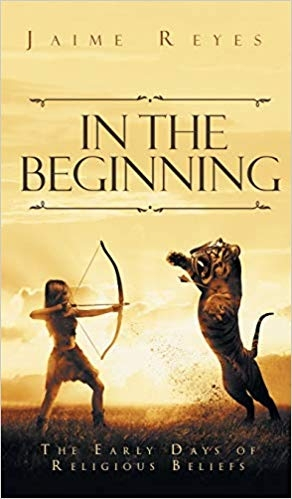
In the Beginning
The Early Days of Religious Beliefs
In the Beginning is a compelling story of family and social evolution.
Jaime Reyes’s historical novel In the Beginning begins in 40,000 BCE as Og, the leader of his Neandertal tribe, uses his lifetime of knowledge to create the role of priest in his community.
Creating religious ceremonies to stave off storms and to ensure a good hunt, Og uses the trappings of the priesthood to gain wealth and power. His made-up religion becomes truth for his community, and he hands down his position of priest through his family line.
Through Og’s children and grandchildren, the religion of Og is brought to the nearby village of the Crom, where a similar hominid species with superior weapons also boasts control over fire. The two communities interact and strengthen each other. The communities expand, creating more villages and coming to believe in their religion more and more.
The introduction of religion is not without conflict. Reyes explores the challenge of the other through antagonist forces from the Crom community. His narrative peaks in an epic armed struggle between the communities, the survivors of which come together to create a joint people. Through the successive generations, the tribes intermarry, their new community becoming a utopian society in which both communities are greater than the sum of their parts. By the third generation, the grandchildren of Og have come to believe that their religion arose organically, though that does not keep headstrong Mina from leaving her mark on the religion, increasing the importance of women and creating her own line of priestesses.
The introduction to the novel argues that all religions are human made and have been corrupted, becoming a means of controlling people in spite of their probable altruistic beginnings. Og is a stand-in for the kind of singular religious leader who can invent the gods of a community’s pantheon and all the religious ceremonies associated with it. Og is built with sympathy, as someone whose motivations are pure: to bring hope and explanations of nature to his people. Still, within the worldview of the novel, it’s clear that religions do not just evolve from a group’s understanding of their universe, but rather because of the manipulations of particular, charismatic leaders.
Such personal interpretations of religious evolution make this a compelling but confusing narrative that’s full of anachronisms. For instance, Og is presented as someone who aims to provide for the religious and spiritual needs of his people, regardless of the validity of his claims. It is unclear how Og, a stand-in for the inventor of religion, would understand the ethics of creating a belief system that would also feed into modern belief.
The epilogue includes detailed, modern research into evolved Neanderthal culture, with the admission that there is no written record of the period, nor is there much archaeological evidence to help with understanding said culture. Still, building on that research, Og’s people are presented as having shocking understandings of medicine, such as knowledge of how to treat gangrenous wounds; comprehension of genetics, as they understand that it is better to marry outside of your family than within it; and concepts of feminism, as within a generation in their community, women are given equal rights in the religion.
In the Beginning is a compelling story of family and social evolution with a positive view of the origins of religions (without arguing that religion is superior). Its is a glimpse of a possible history of a species similar to our own that has often been described as brutish and primitive in nature.
Reviewed by
Holly Jordan
Disclosure: This article is not an endorsement, but a review. The publisher of this book provided free copies of the book and paid a small fee to have their book reviewed by a professional reviewer. Foreword Reviews and Clarion Reviews make no guarantee that the publisher will receive a positive review. Foreword Magazine, Inc. is disclosing this in accordance with the Federal Trade Commission’s 16 CFR, Part 255.
